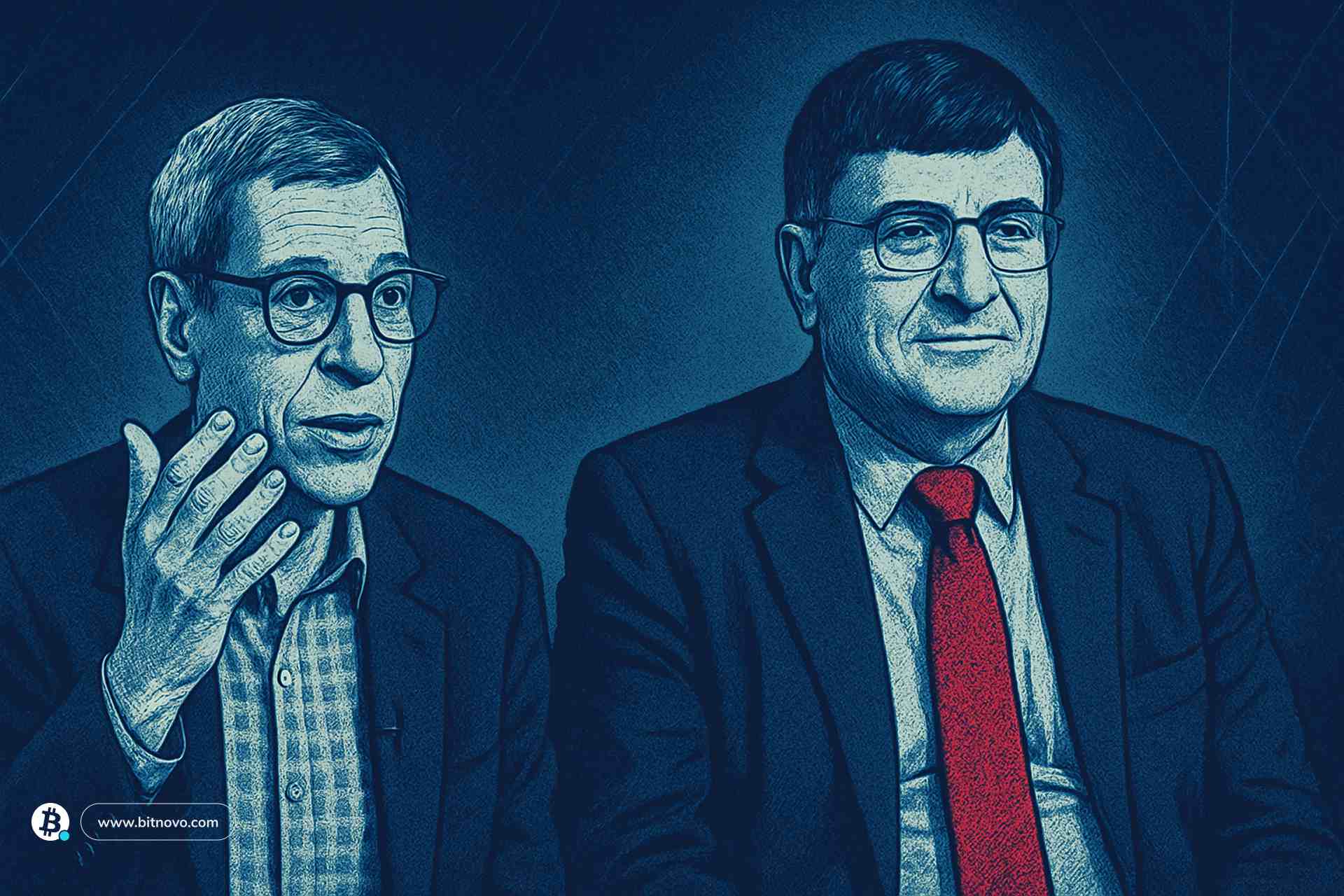Stuart Haber and W. Scott Stornetta: the creators of Blockchain technology

Table of Contents
TogglePeople think of cryptocurrencies and in the next second, they’re already imagining flying cars with cutting-edge technology. What if I told you the crypto future began in a telecommunications lab in the 1990s? Indeed. We hadn’t even mastered the Internet when two mad scientists—well… not that mad—were already solving a problem we didn’t even know we’d have. Basically, they found a way to trust the digital world.
Start preparing a thank-you email because Stuart Haber and W. Scott Stornetta created the technology that now moves millions of dollars. Thanks to them, you now have full control over your crypto, and we have the foundation of everything from finance to digital art.
Their invention didn’t change the world, it simply gave us the tools to be truly free in the digital era—quite something. And what’s most incredible is that they did it decades before anyone else understood its importance. That’s what it means to be ahead of the curve.

Who are Stuart Haber and W. Scott Stornetta?
As mentioned in the earlier spoiler, Stuart Haber and Scott Stornetta are two computer scientists who met at Bell Communications Research (now Nokia Bell Labs) in 1989. By the way, they’re still alive; when we see dates pre-2000, we automatically think of the Cretaceous. They met as young researchers obsessed with a problem that seemed deceptively simple: how to prove a digital document is authentic and hasn’t been altered?
They had the necessary tools. Stuart had a doctorate from Columbia University in secure computational cryptography, and Scott was a specialist in mathematics and scientific research. What more could you want? Astronauts? They were the perfect duo. They saw the iPhone 17 Pro Max while the rest of the world was still using fax machines and cassette tapes.
Here’s the irony: their solution was so ahead of its time that the world took almost 20 years to understand how useful it was. They created something revolutionary for a problem most didn’t even know existed.

A geeky curiosity turned revolution
The story’s got a sense of humour. While working at Bellcore, the two scientists spent their days pondering something that seemed straight out of science fiction. These two aimed to develop a kind of “digital notary” impossible to corrupt.
Picture the scene: two guys in a 90s lab, with computers that now look like dinosaur houses, designing the system that, decades later, would let you buy Bitcoin from your mobile. Laugh now. The world didn’t even have mass email, but they were already solving future problems.
The birth of Blockchain: idea, purpose and first steps
How to put this… The problem they wanted to solve was incredibly simple, yet complex to fix. Let me explain: in a digital world, any file can be copied, modified or forged without leaving a trace. Just ask your parents about your school report cards. The key question was: how to create trust when everything is so easily manipulated?

The solution was clear: create a chain of digital “timestamps” that worked like a wallet. Each link in the chain was glued to the previous one with a unique seal that changes if you touch anything. If anyone tries to delete or change something from a previous link, the seal breaks and everyone knows about their failed superplan.
This is how it works: every time you add new information, the system creates a unique “digital fingerprint” of that information and links it to the fingerprint of the previous info. It’s like chaining padlocks where each one must be linked to the previous to be valid.
The idea was revolutionary, though we didn’t get it then: instead of trusting a central authority, the system would protect itself. If someone tried to alter an old record, the whole subsequent chain would become invalid, like trying to change a domino piece already placed on the table. Ever played dominoes? A bit of general culture. If not, look it up online.

Key publications and patents
These fine folk didn’t just leave it at the idea. They kept contributing. Their pioneering work became various historical milestones. These formed the basis of the entire current crypto ecosystem:
- In 1991: “How to Time-Stamp a Digital Document”. This paper was published in the Journal of Cryptology. It won the prestigious Discover Award for Computer Software in 1992. To this day, it’s considered one of the most important documents in cryptocurrency development.
- Also in 1991: Patent US5136647A. That same year, they secured the patent “Method for secure time-stamping of digital documents”, officially establishing the technical foundations of what is now known as blockchain.
- In 1992: Improvements with Merkle Trees. Alongside Dave Bayer, they incorporated Merkle trees into the design. This hugely improved the system’s efficiency and, for the first time, allowed several document certificates to be grouped into a single block.
- In 1994: Founding of Surety Technologies. They cofounded a spin-off company from Bellcore. This was how they created the world’s first commercial blockchain application, which began operations in 1995 and is still running today. This makes it the oldest continuously operating blockchain.
All these achievements aren’t just docs in a library. They were the instructions to build the decentralised future you’re enjoying today.
Why does their technology remain at the heart of crypto in 2025?
Here’s a one-sentence summary of the answer. Without Haber and Stornetta, you wouldn’t be talking about crypto or decentralisation today. Their 1991 project remains the backbone of Bitcoin, Ethereum, and practically every blockchain that exists. Of course, without Satoshi Nakamoto we wouldn’t be here either, but let’s be clear, Stuart Haber and W. Scott Stornetta built the foundation.

Just look at what Satoshi did. When he wrote the Bitcoin whitepaper in 2008, he cited Haber and Stornetta’s work three times out of eight total references. That wasn’t a coincidence. Bitcoin is essentially the natural evolution of their timestamp system, applied to digital money.
Nowadays, whenever you buy crypto, perform a DeFi transaction or even see an NFT, you’re using the technology these two geniuses created over 30 years ago. Thanks to their system of hash chains and distributed timestamps you can have full control over your digital assets—without banks or intermediaries.
From timestamp chains to Bitcoin
The connection is direct and poetic: Nakamoto took Haber and Stornetta’s timestamp system and added economic incentives, distributed consensus, applying it specifically to money. Basically, he added spice to the base of the soup.

It’s like those two scientists invented car engines in the 90s, and decades later someone said “What if I slap on four wheels and make it a convertible?” The result was Bitcoin, but the engine remained their creation.
What amazes me most is the time leap: from an old telecommunications lab to revolutionising global finance. From basement to world mainstream in two decades.
Where is their impact today?
If you think we can reduce these two brains’ work to just the word “Bitcoin”, you’re very much mistaken. You can see Haber and Stornetta’s technology literally everywhere in the crypto ecosystem:
- In Bitcoin and altcoins: Every block uses their system of chained hashes and immutable timestamps.
- In NFTs: The authenticity and provenance of each non-fungible token is based on their digital certification technology.
- In Smart Contracts: Ethereum and other networks use their structure of linked blocks to execute secure smart contracts.
- In DAOs: Decentralised organisations work because their system enables consensus without requiring a central authority.
- In DeFi: Every decentralised protocol relies on the immutability they invented to operate without middlemen.

Their impact goes beyond a historical moment. It’s so important it’s present and future. Whenever you interact with the crypto ecosystem, you’re using their technology.
Lessons and legacy: what can we learn from these pioneers?
From Haber and Stornetta’s story, there are many lessons. Firstly, real innovation comes from curiosity and an obsession to solve problems others don’t even see coming. They had every reason to stagnate in their era, but saw a future problem and got to work decades before it became urgent.
In my humble opinion, they’re a pair of rebels. Imagine having to solve the problems of future smart flying cars now. You’d probably think: this is impossible, let someone in the future fix it. They were in the same spot, and persevered until they succeeded.

They didn’t accept “that’s just the way it is” and created an alternative that democratised access to systems previously controlled by elites and institutions far out of reach.
So what can you take away from this? Be curious, be rebellious, but above all, be useful—basically what your mum tells you. Seek real problems and become obsessed with solving them before anyone else does. You could be the next disruptor, working on something the world doesn’t yet know it needs. Forget “everything’s been invented” and look beyond.
Ready to join the digital revolution? Explore more and take control from now on. Then come back and tell us how it went, and if you credit us for the motivation, even better. Good luck!




